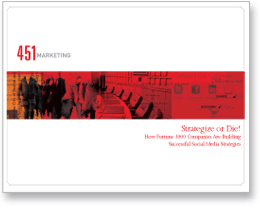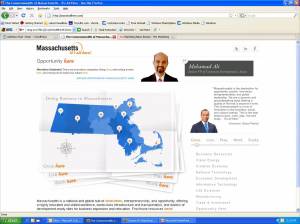 For part four in our series of “451 Heat 1-on1’s,” we spoke with the General Manager of New Media Marketing Labs, Justin Levy. Justin, based in Boston, helps businesses understand the potential of new media marketing, including how to use social media tools like blogs and community platforms to listen to clients and drive business revenue. He is the author of a forthcoming book, “Facebook Marketing: Designing Your Next Marketing Campaign,” and the Partner/General Manager of Caminito Argentinean Steakhouse.
For part four in our series of “451 Heat 1-on1’s,” we spoke with the General Manager of New Media Marketing Labs, Justin Levy. Justin, based in Boston, helps businesses understand the potential of new media marketing, including how to use social media tools like blogs and community platforms to listen to clients and drive business revenue. He is the author of a forthcoming book, “Facebook Marketing: Designing Your Next Marketing Campaign,” and the Partner/General Manager of Caminito Argentinean Steakhouse.
To read more about Justin’s experience using social media to the benefit of his restaurant business, his new book, and his experiences working with Chris Brogan and New Media Marketing Labs, scroll on.
What first compelled you to engrain yourself in the world of new media marketing? Did you immediately recognize the potential that these tools could have for your restaurant business?
I have always used these tools as they continued to evolve. It first started out with forums, user groups, chat rooms, IRC and IM. Over the years it evolved into social networks such as MySpace and Facebook. Of course, the number of social networks have continued to grow and now there are a whole host of networks which make up the tools and core of new media marketing.
As it relates to the restaurant. I began experimenting with these tools because they were free and we needed to find ways to extend our brand. Our issue was never a quality of food or atmosphere inside of the restaurant. But, if no one is coming in and buying your stuff, then all of that other hard work doesn’t matter much. We began using new media marketing as a way to grow our brand, build community and leverage that community to spread the word about our restaurant.
Tell us about New Media Marketing Labs and what sort of brainstorming led to the creation of the popular events, Inbound Marketing Summit and Bootcamps?
New Marketing Labs is a social media agency that was founded by Chris Brogan. We opened at the beginning of 2009. At New Marketing Labs, our team works with medium and large businesses to help them use these tools to move needles that are important to them. We do this by helping them to develop a strategic plan with clear deliverables backed by a strong analytics dashboard. We do everything from strategic development to blogger outreach to manning listening and monitoring stations and a host of other activities related to using social tools to fulfill business needs.
Our Inbound Marketing Summit event is a 2 day conference that was formerly the New Marketing Summit. The New Marketing Summit has been around for approximately 3 years and was run by our parent company, CrossTech Media. When we started New Marketing Labs, we acquired the Inbound Marketing Summit from HubSpot and adopted the name. The Inbound Marketing Summit brings together some of the top thought leaders, marketers, brands, and agencies in the industry to discuss using these tools to take strategy and turn it into action. For 2009 we brought the Summit to 3 cities: San Francisco, Dallas and Boston on October 7th and 8th.
The Inbound Marketing Bootcamps are intensive one-day keyboard level training events. Topics typically include blogging, social networks, social media marketing, listening and monitoring, profile development, reputation management, and how all of this ties into business needs. By the end of 2009 we would’ve held Bootcamps in 5 cities as well as our private Bootcamps we do for brands.
You are currently in the midst of writing what should be a popular book, “Facebook Marketing: Designing Your Next Marketing Campaign.” Even social media savvy individuals and businesses seem to struggle at times to grasp how they should be using Facebook to connect and mobilize fans and prospects around their product or service. Will you address how Facebook should be utilized by B2B marketers to have a more effective reach and engage with potential buyers?
That is exactly the intention of the book. This book is being written for businesses and will, hopefully, provide them the concepts, strategy and tactical information needed to bring Facebook into the fold of their marketing plans. The book will provide a basic overview of features, deep dives into some of the tools that are important for businesses to understand, a review of some of those brands that are considered the “best in class” through their use of Facebook, and how to build a marketing plan that has Facebook as a main component of it.
Every social media marketer seems to have a slogan, or a concept, that they espouse when describing how best to use these tools for business (i.e. “listen to engage’, etc). What is your go-to?
While I have a lot of ways that I tend to explain how I believe these tools should be used by businesses, I tend to return to topics surrounding how these tools allow business to become humanized. Also, that we tend to want to do business with friends. By showing the human side of your business, it allows you to develop these personal relationships with your customers. In turn, they become fans of your business, product, or service and carry forward the message.
I also think that listening and monitoring is the most important thing that any business can do, especially when they’re just starting out. Conversations are taking place all around their brand, products, services, executives, competition and industry. It’s up to them if they’re going to be part of that conversation.
What have you found to be the most useful social media tools for marketing your restaurant? Why do you think this is the case?
The most successful tools for our restaurant have been our listening and monitoring station, blog, video blog, Twitter, Facebook, Yelp, and Flickr. Each of these tools allow us to have two-way conversations with our customers and fans. They also allow people to connect with us on a more personal level and get to see some of what goes on behind-the-scenes at a steakhouse. Tools like Yelp allow us a mechanism for feedback about what our customers like and don’t like.
What kinds of advice do you give to people who are just beginning to get involved with social media?
Start reading as much as possible. Subscribe to blogs that you find valuable and start following those people who you learn from on networks such as Twitter. Also, don’t think you need to start everything at once. You should lay back for a minute and observe everything that is going on and then set a plan on how you want to engage. If you don’t have a clear plan of how you intend to use these tools and what your measures of success are going to be, it will be hard to determine if you’re using the right tools in the proper manner.
Chris Brogan is obviously a very popular figure on the social media web. Can you tell us what the most important thing is that you’ve learned from Chris?
I’m constantly learning from Chris. I’m extremely fortunate to get to work every day with someone that I consider a mentor and a friend. Probably the single most important skill that I continue to learn from Chris is how to build community with trust at its core. In everything that Chris does, one of the reasons he’s able to be so successful is due to how hard he has worked to build and nurture his community. He gives everything he has to his community.
For more information about Justin Levy, visit his blog.








 estion of how to expose (and maybe aggravate) a prospect’s needs without being too obvious about it. How to do it a little more…indirectly.
estion of how to expose (and maybe aggravate) a prospect’s needs without being too obvious about it. How to do it a little more…indirectly. For part four in our series of “451 Heat 1-on1’s,” we spoke with the General Manager of New Media Marketing Labs, Justin Levy. Justin, based in Boston, helps businesses understand the potential of new media marketing, including how to use social media tools like blogs and community platforms to listen to clients and drive business revenue. He is the author of a forthcoming book, “Facebook Marketing: Designing Your Next Marketing Campaign,” and the Partner/General Manager of Caminito Argentinean Steakhouse.
For part four in our series of “451 Heat 1-on1’s,” we spoke with the General Manager of New Media Marketing Labs, Justin Levy. Justin, based in Boston, helps businesses understand the potential of new media marketing, including how to use social media tools like blogs and community platforms to listen to clients and drive business revenue. He is the author of a forthcoming book, “Facebook Marketing: Designing Your Next Marketing Campaign,” and the Partner/General Manager of Caminito Argentinean Steakhouse.